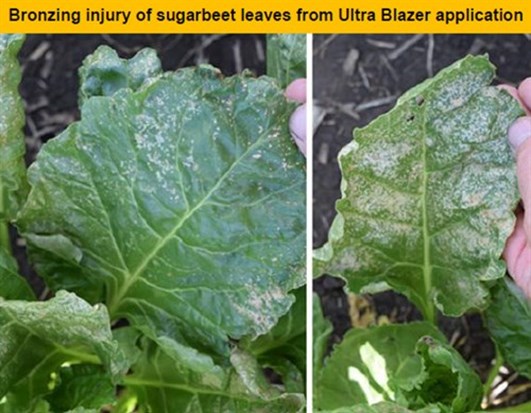619 - Section 18 Label Granted for Ultra Blazer Use in Sugarbeet
A Section 18 emergency use label has been granted for Ultra Blazer use in sugarbeet in Minnesota and North Dakota
EPA agreed to this label since our only viable option for waterhemp control are soil residual herbicides applied as PPI/PRE and Lay-by. The urgency is compounded by lack of rainfall to incorporate herbicides into the soil. Waterhemp escapes not controlled will cause economic losses at levels that warranted the Section 18 Ultra Blazer label to be instated.
It is important to note there should be no changes in your plans in continuing to use soil applied herbicides as the primary control method of glyphosate resistant waterhemp. Ultra Blazer is there to help in controlling any escaped waterhemp.
Research supporting the Section 18 label was conducted by Dr. Tom Peters and graduate student Emma Burt since 2017. Their research demonstrated sugarbeet tolerance and waterhemp control from Ultra Blazer alone or in mixtures with glyphosate. UPL, the makers of Ultra Blazer, are committed in working to obtain a full Section 3 label in sugarbeet.
Notes for Ultra Blazer use in sugarbeet:
- Sugarbeet must be at the 6-leaf stage or greater for an application
- Application prior to 6-leaf stage will result increased injury
- Only one Ultra Blazer application can be made per season
- Ultra Blazer application rate = 16 fl. oz./acre
- Ultra Blazer is the only acifluorfen product approved in sugarbeet
- Can only be applied by ground equipment. Aerial application is prohibited.
- Application Volume – 10-20 gallons of spray solution/broadcast acre
- Target waterhemp less than 4” tall, control is reduced the larger the waterhemp is.
- Ultra Blazer should be applied with a non-ionic surfactant at 0.125% v/v
- Can only be tank-mixed with glyphosate and ammonium sulfate (AMS)
- Do not tank-mix with any pesticides other than glyphosate & AMS
- Use of crop oil or methylated seed oil will significantly increase the potential for visual crop injury
- Restricted Entry Interval (REI) = 48 hours
- Pre-Harvest Interval (PHI) = 45 days
- Do not apply Ultra Blazer after August 1st
Water hemp Control Comparison from Dr. Peter’s Plots
Gly phosate Alone Vs. Glyphosate + Acifluorfen (Ultra Blazer?)

What to Expect for Sugarbeet Injury Symptoms from Ultra Blazer
Bronzing of the sugarbeet leaves may occur as an injury symptom. Necrosis or stature reduction injury in sugarbeet from Ultra Blazer did not reduce root yield or percent sugar in 2019 and 2020 research studies when applied on sugarbeet at the 6-leaf stage or greater.
Yield loss from competing waterhemp will have a far greater impact on reducing sugarbeet yield and quality if waterhemp is left uncontrolled.

Tips to reduce Ultra Blazer Injury to Sugarbeet
Consideration should be taken on the time of day and the environment (temperature & humidity) in which Ultra Blazer applications are made to reduce the chance of sugarbeet injury, just as when we were using only conventional herbicides for weed control in sugarbeet. Risk of injury is increased by high temperatures, over 80°F, and sudden changes from a cool, cloudy environment to a hot, sunny environment.
- Do not apply prior to the sugarbeet 6-leaf stage
- Do not apply in temperatures above 80°F
- Do not apply early in the day if forecasted temperature is to be above 80°F
- Wait until late afternoon/early evening, when temperatures start to decrease, to make Ultra Blazer application
- Do not make applications after 1 a.m. if next day temperatures are forecasted to be over 80°F
- Do not tank-mix with anything but glyphosate & AMS
- Maintain a 3-day interval before and after Ultra Blazer application to apply other pesticides to sugarbeets
